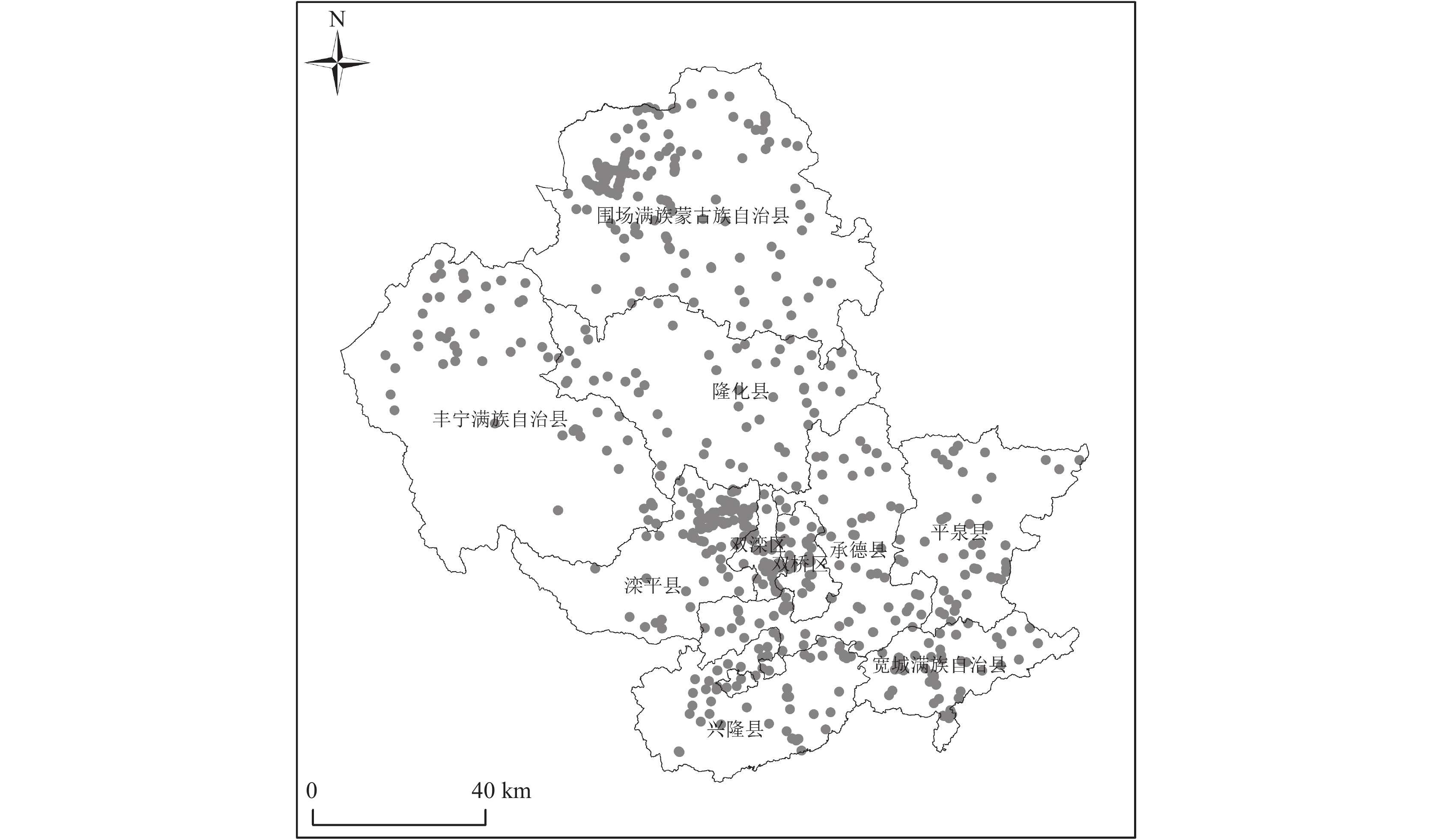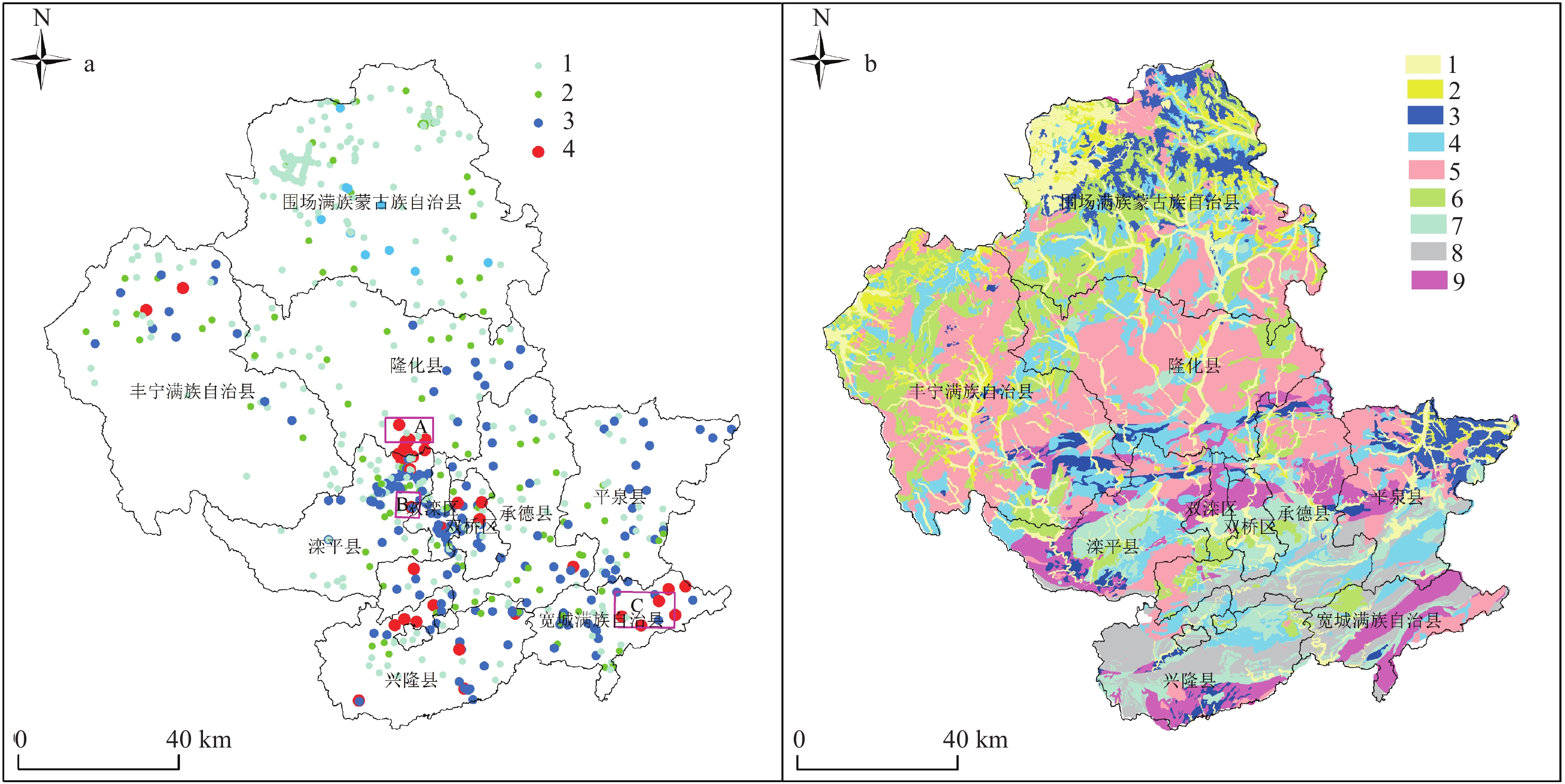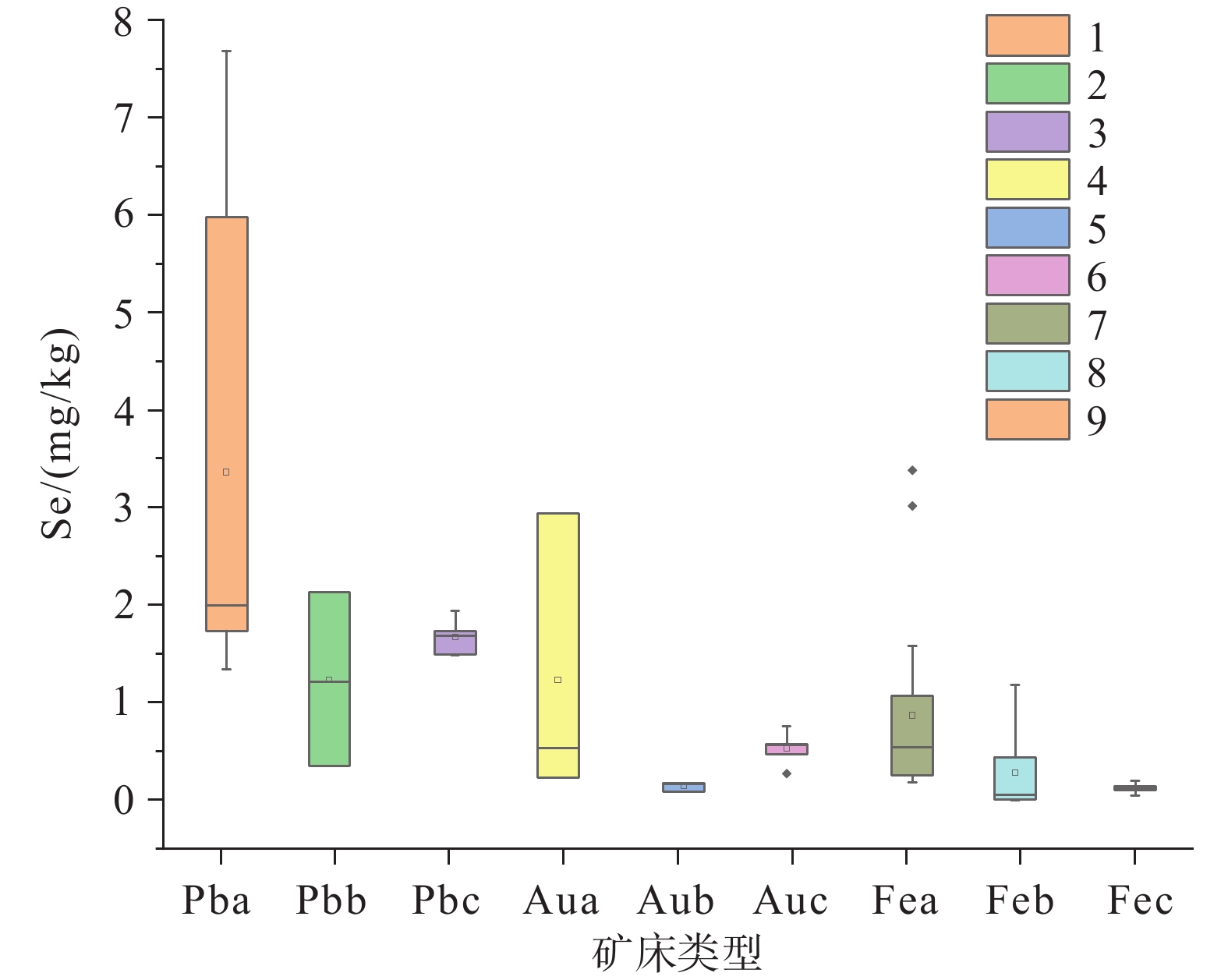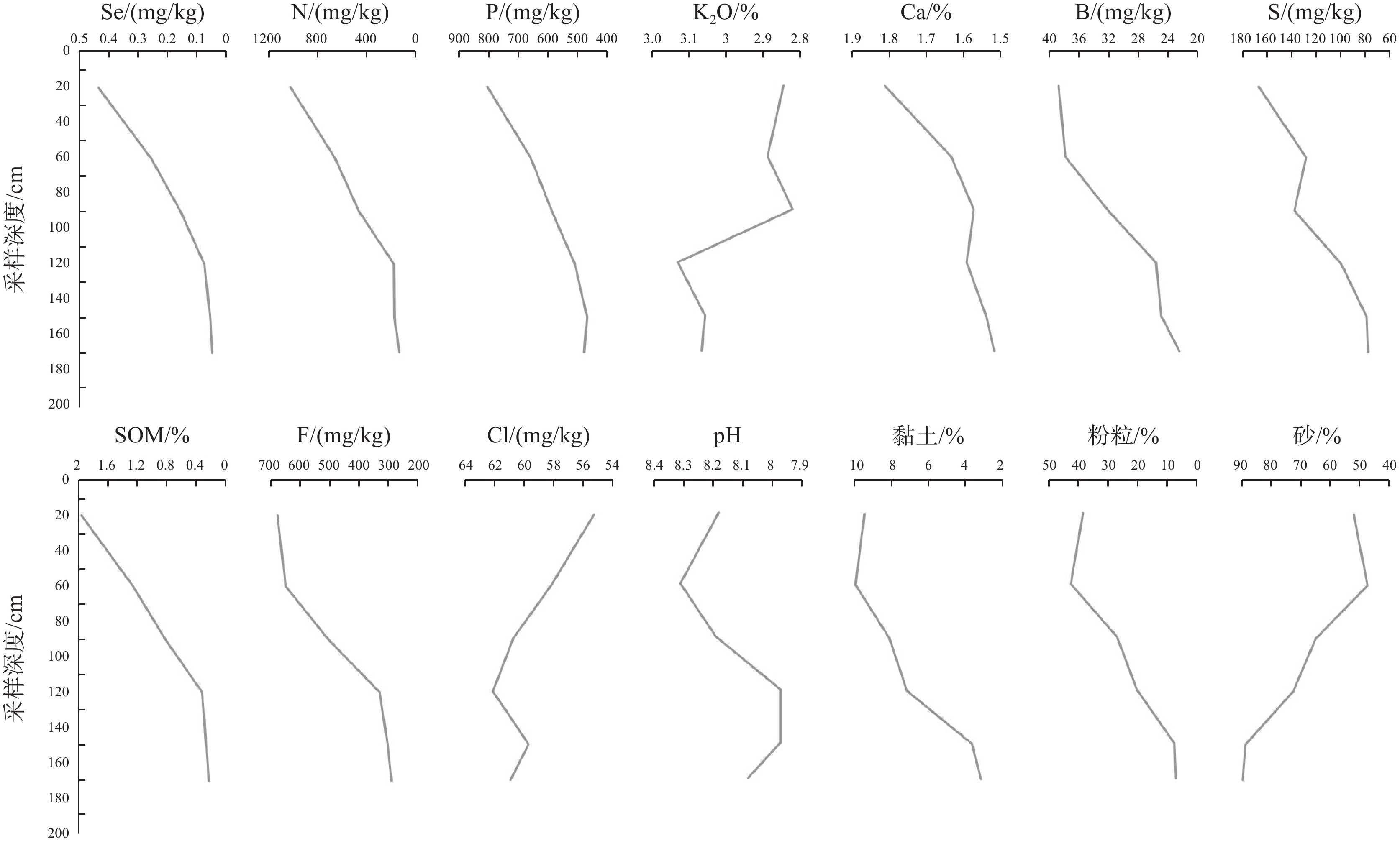Geochemical characteristics, geological genesis and ecological environment evaluation of soil selenium in Chengde, Hebei Province
-
摘要:研究目的
查明承德地区土壤硒的分布特征及地质成因,为当地土壤硒的勘查及有效利用提供科学依据。
研究方法通过地质调查查明该区成土母质类型,利用X−射线荧光光谱法、电感耦合等离子体发射光谱法、凯氏定氮法等获取了553个土壤样品及66件岩矿石样品中硒及多个元素的含量,并利用SPSS软件分析数据,结合地质作用分析地质成因。
研究结果研究区成土母质大致分为9类,表层土壤中硒含量最小值为0.016 mg/kg,最大值为0.743 mg/kg,平均值为0.17 mg/kg,土壤平均硒含量仅为全国土壤平均硒含量的1/2,处于缺乏等级。铁矿石、金矿石、铅锌矿石中硒含量均值分别为0.860 mg/kg、1.233 mg/kg、3.365 mg/kg,明显高于各类矿石的尾矿及围岩。
结论承德地区土壤硒整体含量很低,主要决定于成土母质,分布特征受控于地质建造。富硒土壤区域集中在隆化县南部(A区)、承德市南部(B区)(双滦区、双桥区)、宽城县东部(C区)。C区属于“岩石风化型”,与含硒量高的原生碳酸盐岩+碳质泥岩地层组合有关;B区属于“成矿伴生型”,与铅锌矿成矿过程中硒与金属硫化物的伴生关系及硒与硫的替代关系有关;A区属于“河道沉积型”,与河道沉积过程中河湖冲动力驱动、有机质的吸附作用有关。承德南部富硒区域具有发展林果经济的天然优势,围场县处于低硒环境,是引发克山病等地方病流行的因素之一。
创新点:(1)从土壤形成的地质作用角度研究土壤硒的分布成因。(2)对该富硒区域提出了3种地质成因类型:岩石风化型、 成矿伴生型、河道沉积型。(3) 评价了土壤硒分布对生态环境造成的影响。富硒区域植物茂盛、生态优良,具有发展林果经济的天然优势,低硒环境容易引发地方病。
Abstract:This paper is the result of agricultural geological survey engineering.
ObjectiveThe study aims to delineate the distribution characteristics and geological origins of selenium in the soil of the Chengde area, providing a scientific foundation for the exploration and effective utilization of selenium in the region's soils.
MethodsGeological surveys were conducted to identify the types of soil parent materials in the area. The content of selenium and multiple elements in 553 soil samples and 66 rock/ore samples were determined using X−ray fluorescence spectrometry, inductively coupled plasma emission spectrometry, and the Kjeldahl nitrogen method. Data analysis was performed using SPSS software, with geological genesis being interpreted in conjunction with geological processes.
ResultsThe soil parent materials in the Chengde area are categorized into nine distinct groups. The selenium content in surface soils ranges from a minimum of 0.016 mg/kg to a maximum of 0.743 mg/kg, with an average value of 0.17 mg/kg. This average selenium content is half of the national average, indicating a state of deficiency. The average selenium content in iron ore, gold ore, and lead−zinc ore are 0.860 mg/kg, 1.233 mg/kg, and 3.365 mg/kg, respectively, significantly higher than those in the tailings and wall rocks associated with various ores.
ConclusionsThe overall selenium content in the soils of Chengde is very low, primarily determined by the soil parent materials, with distribution patterns influenced by geological formations. Selenium−rich soil areas are notably concentrated in the south of Longhua County (Area A), the southern parts of Chengde City (Area B) including Shuangluan and Shuangqiao districts, and the eastern part of Kuancheng County (Area C). Area C is characterized as “rock weathering type”, associated with the presence of selenium−enriched primary carbonate rocks and carbonaceous mudstones. Area B is classified as “mineralization associated type”, linked to the symbiotic relationship between selenium and metal sulfides during lead−zinc mineralization, as well as the substitution relationship between selenium and sulfur. Area A is defined as “river sedimentary type”, relating to the dynamics of river and lake sedimentation and the adsorption by organic matter. The selenium−rich region in southern Chengde possesses a natural advantage for developing a forest and fruit economy. Weichang County, situated in a low selenium environment, is identified as a contributing factor in the prevalence of Keshan disease and other endemic conditions.
Highlights:(1) The distribution genesis of selenium in soil is studied from the perspective of geological process of soil formation. (2) Three types of geological genesis are proposed for the selenium−rich area in this area: Rock weathering type, mineralization associated type, and river sedimentary type. (3) The effects of soil selenium distribution on ecological environment were evaluated. The selenium−rich area has lush plants and excellent ecology, and has the natural advantage of developing forest and fruit economy. The low−selenium environment is easy to cause endemic diseases.
-
-
图 1 承德市地形地貌图(a)及地质建造图(b)(据卫晓锋等,2020)
a:1—承德市;2—水库;3—市界;4—省界;5—滦河流域边界;b:1—粗碎屑沉积物堆积;2—细碎屑沉积物;3—砂(砾)岩−粉砂岩建造;4—砂岩建造;5—页岩建造;6—灰岩建造;7—白云岩建造;8—铁锰白云岩建造;9—角闪岩−变粒岩建造;10—片麻岩建造;11—玄武岩建造;12—安山岩建造;13—英安岩−流纹岩建造;14—花岗岩建造;15—二长花岗岩建造
Figure 1. Topographic map (a) and geological construction map of Chengde City (b) (after Wei Xiaofeng et al., 2020)
a: 1−Chengde City; 2−Reservoir; 3−City boundary; 4−Provincial boundary; 5−Luanhe River Basin boundary; b: 1−Coarse clastic sediment accumulation; 2−Fine clastic sediments; 3−Sand (gravel) rock−siltstone formation; 4−Sandstone formation; 5−Shale formation; 6−Limestone formation; 7−Dolomite formation; 8−Ferromanganese dolomite formation; 9−Amphibole−metamorphic formation; 10−Gneiss formation; 11−Basalt formation; 12−Andesite formation; 13−Dacite−rhyolite formation; 14−Granite formation; 15−Monzonitic granite formation
图 3 承德市表层土壤富硒等级图(a)和成土母质分布图(b)
a:1—缺乏 (≤0.125 mg/kg); 2—边缘 (0.125~0.175 mg/kg); 3—适量 ( 0.175~0.40 mg/kg); 4—高 ( > 0.4 mg/kg);b:1—冲湖积物母质;2—风积黄土母质;3—基性岩残积母质;4—中性岩残积母质;5—酸性岩残积母质;6—火山碎屑岩母质;7—砂页岩母质;8—碳酸盐岩母质;9—片麻岩变质岩母质
Figure 3. Se-rich level map (a) and parent material distribution map (b) of topsoil in Chengde City
a:1−Lack (≤0.125 mg/kg); 2−Edge (0.125−0.175 mg/kg); 3−Moderate ( 0.175−0.40 mg/kg); 4−High ( > 0.4 mg/kg); b:1−Alluvial sediments parent material; 2−Aeolian loess parent material; 3−Basic rock residual parent material; 4−Neutral rock residual parent material; 5−Acid rock residual parent material; 6−Volcanic clastic rock parent material; 7−Sand shale parent material; 8−Carbonate parent material; 9−Gneiss metamorphic rocks parent material
图 4 承德市主要矿床类型的硒含量等级图
Pba—铅锌矿石; Pbb—铅锌矿围岩;Pbc—铅锌矿尾矿;Aua—金矿矿石;Aub—金矿围岩;Auc—金矿尾矿;Fea—铁矿矿石;Feb—铁矿围岩;Fec—铁矿尾矿
Figure 4. Selenium content grade diagram of main deposit types in Chengde City
Pba−Lead−zinc ore; Pbb−Lead−zinc rock; Pbc−Lead−zinc mine tailings; Aua−Gold ore; Aub−Host rock of gold deposit; Auc−Tailings from gold deposit; Fea−Iron ore; Feb−Host rock of iron deposit; Fec−Tailings from iron ore
表 1 承德市表层(0~20 cm)土壤硒含量(n=553个)及其他国家和地区土壤硒含量统计
Table 1 Statistics of selenium content in surface layer (0−20 cm) soil of Chengde City (n=553)
地区 最小值
/(mg/kg)最大值
/(mg/kg)均值
/(mg/kg)参考文献 承德 0.016 0.734 0.170 本文 中国 0.05 0.99 0.29 何振立,1998 世界 0.03 2.00 0.40 Fordyce, 2007 美国 — — >3 冯辉等,2019 英格兰 — — >3 冯辉等,2019 日本耕作土壤 — — 0.51 Yanai et al., 2015 比利时 0.04 0.27 0.11 Robberecht et al., 1982 黑龙江松嫩平原
南部土壤— — 0.20 夏学齐等, 2012 重庆市江津区 — — 0.27 付婷婷等, 2019 浙江中部典型
富硒区土壤— — 0.40 黄春雷等, 2013 宁夏青铜峡
农耕土土壤— — 0.23 李晓慧等, 2018 广东 0.03 1.42 0.28 陈俊坚等, 2012 贵州 — — 0.37 何亚琳, 1996 表 2 承德市表层(0~20 cm)不同成土母质区土壤硒含量统计(n=553个)(mg/kg)
Table 2 Statistics of selenium content in different soil−forming parent material areas in the surface layer (0−20 cm) of Chengde City (n=553) (mg/kg)
序号 母质类型 代号 位置 样品数量 最小值 最大值 均值 标准偏差 方差 变异系数(CV)/% 富集系数(Ei) 1 河湖冲积物 A 围场县外 72 0.04 0.73 0.18 0.12 0.015 70.20 0.93 A 围场县 41 0.01 0.25 0.10 0.05 0.002 51.37 0.51 2 风积黄土 B 围场县外 8 0.06 0.21 0.12 0.05 0.003 46.06 0.63 B 围场县 57 0.02 0.17 0.08 0.04 0.002 51.43 0.42 3 基性岩残积 C 围场县外 14 0.02 0.34 0.13 0.09 0.008 67.75 0.71 C 围场县 27 0.02 0.21 0.09 0.05 0.003 54.67 0.49 4 中性岩残积 D 围场县外 61 0.02 0.59 0.17 0.12 0.015 73.78 0.87 D 围场县 18 0.04 0.15 0.09 0.03 0.001 30.22 0.49 5 酸性岩残积 E 围场县外 78 0.02 0.38 0.16 0.08 0.007 49.91 0.85 E 围场县 10 0.03 0.38 0.14 0.10 0.010 68.36 0.75 6 火山碎屑岩 F 围场县外 63 0.02 0.47 0.16 0.10 0.010 62.88 0.83 F 围场县 30 0.02 0.29 0.11 0.07 0.005 67.10 0.57 7 碳酸盐岩 G 围场县外 66 0.02 0.50 0.20 0.13 0.016 61.76 1.07 8 砂页岩残积 H 围场县外 63 0.02 0.57 0.17 0.10 0.011 61.75 0.89 9 片麻岩变质岩 L 围场县外 64 0.02 0.63 0.18 0.13 0.019 70.29 0.97 表 3 承德主要矿床类型中Se含量统计
Table 3 Selenium content statistics in major ore deposits of Chengde City
样品类型 个数(N) 最小值
/(mg/kg)最大值
/(mg/kg)均值
/(mg/kg)标准
偏差方差 铁矿石 18 0.180 3.380 0.860 0.930 0.860 铁矿围岩 6 0.100 0.140 0.120 0.020 0.000 铁矿尾矿 15 0.010 1.180 0.280 0.410 0.170 金矿石 3 0.229 2.942 1.233 1.214 1.475 金矿围岩 3 0.087 0.173 0.141 0.039 0.001 金矿尾矿 5 0.268 0.754 0.528 0.158 0.025 铅锌矿 7 1.336 7.685 3.365 2.284 5.217 锌矿围岩 6 0.347 2.129 1.472 0.918 0.843 铅锌矿尾矿 3 1.489 1.687 1.558 0.091 0.008 表 4 承德地区地质建造(据卫晓锋等,2020)
Table 4 Geological formations in Chengde area (after Wei Xiaofeng et al., 2020)
序号 大类地质建造 亚建造 1 堆积建造 砂−砾石、砂−亚黏土亚建造 2 碳酸盐岩建造 灰岩、白云岩、铁锰白云岩亚建造 3 碎屑岩建造 砂岩、粉砂岩、页岩亚建造 4 花岗岩类建造 花岗岩、 二长花岗岩亚建造 5 火山岩建造 英安岩−流纹岩、安山岩、玄武岩亚建造 6 片麻岩建造 片麻岩、角闪变粒岩亚建造 表 5 隆化县铅锌矿区土壤元素统计
Table 5 Statistical analysis of soil elements in the lead−zinc mine area of Longhua County
元素 个数(N) 最小值 最大值 均值 标准偏差 方差 Se 16 0.41 0.98 0.52 0.16 0.03 N 16 72.00 5966.00 3874.00 1764.84 3114655.87 P 16 562.40 6578.00 1400.09 1445.21 2088635.36 K 16 96547.77 246579.36 206628.17 44717.99 1999698188.87 Ca 16 8390.50 101986.73 23392.05 29104.36 847063811.70 S 16 331.60 7092.00 1276.56 2094.22 4385749.64 Fe 16 26485.11 96322.20 40044.84 21897.69 479508864.22 Mn 16 1312.00 3105.00 1899.19 564.51 318671.90 Cu 16 18.69 191.40 41.62 44.66 1994.93 Zn 16 97.41 1208.00 272.76 326.23 106428.78 Mo 16 0.20 4.05 1.16 0.92 0.85 B 16 2.27 45.52 32.23 12.79 163.70 Ge 16 1.01 1.50 1.23 0.13 0.02 F 16 359.32 1568.27 583.20 314.04 98623.72 Som 16 0.15 12.80 8.29 3.97 15.74 pH 16 6.25 9.08 7.01 0.79 0.62 YXN 16 6.01 540.54 339.53 159.74 25517.82 YXP 16 0.10 29.04 10.58 7.66 58.69 YXK 16 15.15 798.38 389.36 220.96 48825.33 Cr 16 49.15 78.01 59.66 8.00 63.93 Cd 16 0.11 6.85 1.21 1.93 3.71 Ni 16 21.90 48.52 28.96 6.99 48.80 Co 16 8.67 100.60 20.67 26.40 696.78 Pb 16 2.39 2539.00 334.26 734.15 538978.03 As 16 1.07 14.16 8.18 3.40 11.59 Hg 16 0.00 0.44 0.09 0.10 0.01 注:Som、YXN、YXP、YXK单位为10−2,pH无单位,其他为10−6。 表 6 隆化县铅锌矿区土壤元素相关性系数统计
Table 6 Correlation coefficient statistics for soil elements in the lead−zinc mining area of Longhua County
元素 Se N P K Ca S B Ge F Som YXN YXP YXK r — −0.15 −0.15 0.05 −0.10 −0.02 0.17 −0.21 −0.02 −0.21 −0.15 −0.09 −0.23 P 0.58 0.58 0.86 0.71 0.93 0.53 0.44 0.93 0.42 0.57 0.73 0.39 元素 pH Cr Cd Ni Co Pb As Hg Cu Zn Mo Fe Mn r −0.26 −0.02 0.93 −0.12 −0.02 0.90 0.40 0.64 0.09 0.87 0.72 −0.04 0.69 P 0.33 0.95 0.00 0.65 0.95 <0.01 0.13 0.01 0.73 <0.01 0.00 0.87 0.00 注:r—相关系数;p—显著性水平。 表 7 承德市南部伊逊河流域河漫滩和一级阶地上表层土壤元素含量
Table 7 Contents of surface soil elements on the floodplain and first-level terraces of the Yixun River Basin in the south of Chengde City
元素 个数(N) 最小值 最大值 均值 标准偏差 方差 Se 74 0.41 2.86 0.61 0.41 0.17 N 74 159.00 2926.00 1381.65 513.55 263731.85 P 74 80.99 2441.00 941.37 445.21 198214.84 K 74 49193.82 289570.45 227101.59 48196.07 2322860843.44 Ca 74 9355.34 221197.57 26912.80 36120.70 1304704614.85 S 74 149.70 6312.00 527.44 1024.33 1049244.02 Fe 74 18523.50 113797.20 44684.99 13371.47 178796189.17 Mn 74 376.80 2999.00 810.45 392.00 153660.85 Cu 74 13.97 77.56 36.35 10.92 119.27 Zn 74 19.19 498.20 104.04 53.57 2869.43 Mo 74 0.18 3.30 1.39 0.55 0.30 B 74 15.89 88.31 37.78 8.91 79.31 Ge 74 0.12 2.07 1.35 0.26 0.07 F 74 375.75 9366.18 828.88 1027.89 1056550.71 Som 74 0.36 8.54 3.13 1.59 2.51 pH 74 5.70 9.40 7.94 0.54 0.30 YXN 74 9.71 277.22 113.72 50.08 2507.84 YXP 74 0.68 353.40 26.96 55.19 3046.11 YXK 74 35.71 734.80 219.74 131.96 17412.65 Cr 74 47.96 614.80 100.34 83.62 6992.48 Cd 74 0.01 0.37 0.19 0.06 0.00 Ni 74 5.11 47.06 30.98 7.98 63.64 Co 74 8.59 23.16 15.00 3.15 9.95 Pb 74 1.85 95.58 27.85 10.61 112.51 As 74 0.35 15.92 10.13 3.51 12.30 Hg 74 0.00 0.80 0.08 0.11 0.01 注:Som、YXN、YXP、YXK单位为10−2,pH无单位,其他为10−6。 表 8 陈栅子乡一带土壤元素相关性系数统计
Table 8 Statistics of correlation coefficients of soil elements in Chenzhazi township
元素 Se N P K Ca S B Ge F SOM YXN YXP YXJ r 1 −0.29 0.33 −0.51 0.24 0.31 0.21 0.22 0.04 0.37 −0.31 −0.06 0.08 P 0.01 0.00 0.00 0.04 0.01 0.07 0.06 0.75 0.00 0.01 0.60 0.51 元素 pH Cr Cd Ni Co Pb As Hg Cu Zn Fe Mn Mo r 0.21 0.22 −0.08 −0.06 0.05 0.15 −0.25 0.06 0.36 −0.04 0.18 0.13 0.24 P 0.08 0.06 0.52 0.64 0.71 0.21 0.03 0.61 0.00 0.76 0.12 0.27 0.05 -
[1] Brantley S L, Goldharber M B, Ragnarsdottir K V. 2007. Crossing disciplines and scales to understand the critical zone[J]. Elements, 3(5): 307−314. doi: 10.2113/gselements.3.5.307
[2] Chang C Y, Yin R S, Wang X, Shao S X, Chen C Y, Zhang H. 2019. Selenium translocation in the soil−rice system in the Enshi seleniferous area, Central China[J]. Science of the Total Environment, 669: 83−90. doi: 10.1016/j.scitotenv.2019.02.451
[3] Chen Dongping, Zhang Jinpeng, Nie Hefei, Li Xingyuan, Shen Wenjie, Huang Meicong. 2012. Selenium distribution in soils of Lianzhou city, mountain area of northern Guangdong Province and its influencing factors[J]. Acta Scientiae Circumstantiae, 41(7): 1−11 (in Chinese with English abstract).
[4] Chen Junjian, Zhang Huihua, Yu Weimin, Liu Jianming. 2012. Spatial variation and environmental indications of soil selenium in Guangdong Province[J]. Ecology and Environmental Sciences, 21(6): 1115−1120 (in Chinese with English abstract).
[5] Cheng Xiaomeng, Wu Chao, Sun Binbin, He Ling, Zeng Daoming. 2021. Selenium−rich characteristics and risk assessment of heavy metals in soil and crop in a typical black shale area of the central part of Zhejiang Province, China[J]. Geoscience, 35(2): 425−433 (in Chinese with English abstract).
[6] Cook N J, Ciobanu C L, Pring A, Skinner W, Shimizu M, Danyushevsky L, Saini−Eidukat B, Melcher F. 2009. Trace and minor elements in sphalerite: A LA−ICPMS study[J]. Geochimica et Cosmochimica Acta, 73(16): 4761−4791. doi: 10.1016/j.gca.2009.05.045
[7] Ding Qiuhong, Tang Tao, Wang Lingguang, Chen Shuwang, Xing Dehe. 2021. Geochemical study on selemium in rock−soil−plant in northern Liaoning Province[J]. Geology and Resources, 30(5): 570−576 (in Chinese with English abstract).
[8] Dong Huiqiu, Liu Zhongchen. 1995. Epidemic situation of Keshan disease in Chengde area[J]. Journal of Chengde Medical College, 12(4): 351−353 (in Chinese).
[9] Ellis D R, Salt D E. 2003. Plants selenium and human health[J]. Current Opinion in Plant Biology, 6: 273−279. doi: 10.1016/S1369-5266(03)00030-X
[10] Feng Hui, Zhang Xuejun, Zhang Qun, Du Lina. 2019. Distribution characteristics and sources identification of selenium−rich soils in the ecological conservation area of the Daqinghe River Watershed, Beijing[J]. Rock and Mineral Analysis, 38(6): 693−704 (in Chinese with English abstract).
[11] Fordyce F M. 2007. Selenium geochemistry and health[J]. Ambio, 36: 94−97. doi: 10.1579/0044-7447(2007)36[94:SGAH]2.0.CO;2
[12] Fu Tingting, Zhang Wei, Zeng Tingting, Wang Na, Huang Yongchuan. 2019. Accumulation and migration characteristics of selenium and heavy metals in soil−rice[J]. Southwest China Journal of Agricultural Sciences, 32(4): 843−847 (in Chinese with English abstract).
[13] Girling C A. 1984. Selenium in agriculture and the environment[J]. Agriculture Ecosystems and Environment, 11(1): 37−65. doi: 10.1016/0167-8809(84)90047-1
[14] Guo Jingfen, Zhang Lijian. 2016. Types and geological characteristics of the iron deposits in Chengde[J]. China's Manganese Industry. 34(5): 35−37 (in Chinese with English abstract).
[15] He Yalin. 1996. Se contents and distribution in soils of Guizhou Province[J]. Acta Pedologica Sinica, 33(4): 391−397 (in Chinese with English abstract).
[16] He Zhenli, Zhou Qixing, Xie Zhengmiao. 1998. Soil Chemical Balance of Pollution and Beneficial Elements[M]. Beijing: China Environmental Science Press (in Chinese).
[17] Hewawasam T, Blanckenburg F V, Bouchez J, Dixon J L, Schuessler J A, Maekeler R. 2013. Slow advance of the weathering front during deep, supply−limited saprolite formation in the tropical Highlands of Sri Lanka[J]. Geochimica et Cosmochimica Acta, 118: 202−230. doi: 10.1016/j.gca.2013.05.006
[18] Hu Yanhua, Wang Jiaen, Cai Zihua, Song Mingyi, Kang Zhanjun, Yan Tiezeng. 2010. Content, distribution and influencing factors of soil selenium in Jiashan area of Northern Zhejiang Province[J]. Geological Science and Technology Information, 29(6): 84−88 (in Chinese with English abstract).
[19] Huang Chunlei, Wei Yingchun, Jian Zhonghua, Song Mingyi. 2013. Study on selenium contents and combined froms of typical selenium−rich soil in the central part of Zhejiang Province[J]. Earth and Environment, 41(2): 155−159 (in Chinese with English abstract).
[20] Ji Huawei, Ren Rui, Chen Jiping, Zhang Jijun, Li Aorui, Feng Weihua. 2021. Characterstics of selenium content in different soil types in Guanzhong and its influence on selenium content of corn grain[J]. Northwestern Geology, 54(4): 239−249 (in Chinese with English abstract).
[21] Joseph J, Loscalzo J. 2013. Selenistasis: Epistatic effects of selenium on cardiovascular phenotype[J]. Nutrients, 5(2): 340−358. doi: 10.3390/nu5020340
[22] Li Xiaohui, Gao Yu, Zhao Wanfu, Liu Zhijian. 2018. Distribution characteristics of selenium in cultivated soil and its influencing factors in Qingtongxia City of Ningxia[J]. Journal of Agricultural Resources and Environment, 35(5): 422−429 (in Chinese with English abstract).
[23] Lin Y, Cook N J, Ciobanu C L, Liu Y P, Zhang Q, Liu T G, Gao W, Yang Y L, Danyushevskiy L. 2011. Trace and minor elementsin sphalerite from base metal deposits in South China: A LA−ICPMS study[J]. Ore Geology Reviews: Journal for Comprehensive Studies of Ore Genesis and Ore Exploration, 39: 188−217.
[24] Liu Daorong, Jiao Sen. 2021. Assessment of genetic classification and development suitability of natural selenium−rich soil[J]. Geophysical and Geochemical Exploration, 45(5): 1157−1163 (in Chinese with English abstract).
[25] Liu X J, Yang K, Guo F, Tang S Q, Liu Y H, Zhang L, Cheng H X, Liu F. 2022. Effects and mechanism of igneous rock on selenium in the tropical soil−rice system in Hainan Province, South China[J]. China Geology, 5(1): 1−11.
[26] Long Zedong. 2020. A Study on Distribution Characteristics and Health Effects of Selenium in Soil−Crop−Human System in the Se−rich Area Enshi and Shitai, China[D]. Hefei: University of Science and Tecnology of China (in Chinese with English abstract).
[27] Lu Qing, Tang Haifeng, Guo Lianbi, Hou Shaofan, Zhu Zhenyuan. 1987. The relationship between Kaschin−Beck disease and environmental low selenium in Chengde area[J]. Journal of Chengde Medical College, 2: 9−11 (in Chinese).
[28] Mao Xiangju, Liu Lu, Cheng Xintao Hu Quanhui, Xiao Fang, Ni Wen Shan. 2021. Geochemistry and spatial distribution of element in soils of typical Se−rich area in Xinmin, Henan Province[J]. Geological Bulletin of China, 40(10): 1664−1670 (in Chinese with English abstract).
[29] Mast M A, Mills T J, Paschke S S, Keith G, Linard J L. 2014. Mobilization of selenium from the Mancos Shale and associated soils in the lower Uncompahgre River Basin, Colorado[J]. Applied Geochemistry, 48: 16−27. doi: 10.1016/j.apgeochem.2014.06.024
[30] Robberecht H, Berghe D V, Deelstra H, Grieken R V. 1982. Selenium in the Belgian soils and its uptake by rye−grass[J]. Science of the Total Environment, 25: 61−69. doi: 10.1016/0048-9697(82)90042-0
[31] Sager M. 2006. Selenium in agriculture, food and nutrition[J]. Pure and Applied Chemistry, 78: 111−133. doi: 10.1351/pac200678010111
[32] Song Xiaoke, Li Zongren, Wang Jingui. 2018. Distribution and influential factors of soil Se in eastern Qinghai Province[J]. Soil, 50(4): 755−761 (in Chinese with English abstract).
[33] Tu Guangzhi, Gao Zhenmin, Hu Ruizhong, Zhang Qian, Li Chaoyang, Zhao Zhenhua, Zhang Baogui. 2003. Dispersed Element Geochemistry and Ore−Forming Mechanisms[M]. Beijing: Geological Publishing House (in Chinese).
[34] Wan Chuanjie, Li Li, Li Shaozheng, Li Guangshun, Hao Zhimin, Kang Kang. 2019. Genesis of siliceous rocks of Gufeng Formation in Shuanghe area of Enshi and analysis of selenium source[J]. Western Exploration Engineering, 9: 127−130 (in Chinese with English abstract).
[35] Wang Jinda, Yu Junbao, Zhang Xuelin. 2000. Geochemical characteristics of selenium and other elements in Loess Plateau Soil[J]. Geoscience, 20(5): 469−473 (in Chinese with English abstract).
[36] Wang Rui, Yu Tao, Yang Zhongfang, Hou Qingye, Zeng Qingliang, Ma Honghong. 2018. Bioavailability of soil selenium and its influencing factors in selenium−enriched soil[J]. Resources and Environment in the Yangtze Basin, 27(7): 1647−1654 (in Chinese with English abstract
[37] Wang Shiji, Wu Xiaoyong, Liu Junbao. 2004. Characteristics of elemental selenium in soils and evaluation of eco−environmental effects in northern Zhejiang[J]. Geology in China, 31(S1): 118−125 (in Chinese with English abstract).
[38] Wang Zhuo. 2020. The Mineral Typomorphic Characteristics, Ore−Forming Fluid Characteristics and Deposit Genesis of Jidongyu Erya Gold Deposit[D]. Beijing: China University of Geosciences (Beijing) (in Chinese).
[39] Wei Xiaofeng, Wang Jingbin, Sun Houyun, Yin Zhiqiang, He Zexin, Jia Fengchao, Li Xia, Liu Hong, Zhang Jing. 2020. Exploration of land use optimization path based on geological formation in Chengde City[J]. Hydrogeology & Engineering Geology, 47(6): 15−25 (In Chinese with English abstract).
[40] Wen Hanjie, Zhou Zhengbing, Zhu Chuanwei, Luo Chongguang, Wang Dazhao, Du Shengjiang, Li Xiaofeng, Chen Maohong, Li Hongyi. 2019. Critical scientific issues of super−enrichment of dispersed metals[J]. Acta Petrologica Sinica, 35(11): 3271−3291 (In Chinese with English abstract). doi: 10.18654/1000-0569/2019.11.01
[41] Winkel L H E, Johnson C A, Lenz M, Grundl T, Leupin O X, Amini M, Charlet L. 2012. Environmental selenium research: From microscopic processes to global understanding[J]. Environmental Science and Technology, 46(2): 571−579. doi: 10.1021/es203434d
[42] Winkel L, Vriens B, Jones G, Schneider L S, Pilon−Smits E, Banuelos G. 2015. Selenium cycling across soil plant almosphere: A critical review[J]. Nutrients, 7(6): 4199−4239. doi: 10.3390/nu7064199
[43] Wu Jun. 2018. The distribution of soil selenium in Shouning County of Fujian Province and its influencing factors[J]. Geology in China, 45(6): 1167−1176 (in Chinese with English abstract).
[44] Wu Xingsheng. 2021. Characteristics and genesis of selenium−rich soil in Wuping area, Fujian Province[J]. Geophysical and Geochemical Exploration, 45(3): 778−784.
[45] Xia Xueqi, Yang Zhongfang, Xue Yuan, Cui Yujun, Li Yansheng, Hou Qingye, Yu Tao. 2012. Geochemical circling of soil Se on the southern Song−Nen Plain, Heilongjiang Province[J]. Geoscoence, 26(5): 850−858, 864 (in Chinese with English abstract).
[46] Xie Wei, Yang Yaodong, Hou Jiayu, Li Guocheng, Jian Guiqin. 2019. Studies on causes and influential factors of selenium−enriched soils in Jizhou district of Tianjin[J]. Geophysical and Geochemical Exploration, 43(6): 1373−1381 (in Chinese with English abstract).
[47] Xing Y J, Liu Z W, Yang G, Gao D F, Niu X L. 2015. Micro RNA expression profiles in rats with selenium deficiency and the possible role of the Wnt/beta−catenin signaling pathway in cardiac dysfunction[J]. International Journal of Molecular Medicine, 35(1): 143−152. doi: 10.3892/ijmm.2014.1976
[48] Xu Yuefeng, Hao Zhe, Li Yonghua, Li Hairong, Wang Li, Zang Zhenfeng, Liao Xiaoyong, Zhang Ru. 2020. Distribution of selenium and zinc in soil−crop system and their relationship with environmental factors[J]. Chemosphere, 242: 1−9.
[49] Xu Zhenhai, Wu Lina. 2012. Preliminary study on the spatial distribution rules of gold, silver, lead and zinc deposits and prospecting potential in Longhua area, Hebei[J]. Mineral Exploration, 3(6): 774−779 (in Chinese with English abstract).
[50] Yanai J, Mizuhara S, Yamada H. 2015. Soluble selenium content of agricultural soils in Japan and its determining factors with reference to soil type, land use and region[J]. Soil Science and Plant Nutrition, 61(2): 312−318. doi: 10.1080/00380768.2014.997147
[51] Yang Zhizhong, Zhou Wenlong, Luo Yongjun, Pu Qinglong, Linghu Dong, Song Xiaojun. 2012. Distribution of soil selenium of the cultivated land and its controlling factors in Zhenyuan of Guizhou Province[J]. Geoscience, 35(2): 434−442 (in Chinese with English abstract).
[52] Yu T, Yang Z F, Lü Y Y, Hou Q Y, Xia X Q, Feng H Y, Zhang M, Jin L X, Kan Z Z. 2014. The origin and geochemical cycle of soil selenium in a Se−rich area of China[J]. Journal of Geochemical Exploration: Journal of the Association of Exploration Geochemists, 139: 97−108. doi: 10.1016/j.gexplo.2013.09.006
[53] Zhao Jun, Zhang Zhehuan, Mu Huayi, Wang Xin, Liang Shuai. 2021. Study on selenium in soil and crops in the high incidence areas of Keshan disease[J]. Northwestern Geology, 54(4): 250−258 (in Chinese with English abstract).
[54] Zhou Jiaxi, Luo Kai, Sun Guotao. 2021. Se extremely enriched in the Dingtoushan Pb−Zn deposit, Qinglong City, Guizhou Province, China[J]. Geology in China, 48(1): 339−340 (in Chinese).
[55] 陈东平, 张金鹏, 聂合飞, 李兴远, 沈文杰, 黄美聪. 2012. 粤北山区连州市土壤硒含量分布特征及影响因素研究[J]. 环境科学学报, 41(7): 1−11. [56] 陈俊坚, 张会化, 余炜敏, 刘鉴明. 2012. 广东省土壤硒空间分布及潜在环境风险分析[J]. 生态环境学报, 21(6): 1115−1120. doi: 10.3969/j.issn.1674-5906.2012.06.022 [57] 成晓梦, 吴超, 孙彬彬, 贺灵, 曾道明. 2021. 浙江中部典型黑色岩系分布区土壤−作物富硒特征与重金属风险评价[J]. 现代地质, 35(2): 425−433. [58] 丁秋红, 唐韬, 王龄广, 陈树旺, 邢德和. 2021. 辽宁北部地区岩石−土壤−植物中硒元素地球化学研究[J]. 地质与资源, 30(5): 570−576 [59] 董汇秋, 刘中忱. 1995. 承德地区克山病流行概况[J]. 承德医学院学报, 12(4): 351−353. [60] 冯辉, 张学君, 张群, 杜丽娜. 2019. 北京大清河流域生态涵养区富硒土壤资源分布特征和来源解析[J]. 岩矿测试, 38(6): 693−704. [61] 付婷婷, 张伟, 曾婷婷, 王娜, 黄永川. 2019. 重庆江津区土壤−稻米中硒和重金属的积累及迁移特征[J]. 西南农业学报, 32(4): 843−847. [62] 郭静粉, 张立剑. 2016. 承德地区铁矿类型及其地质特征[J]. 中国锰业, 34(5): 35−37. [63] 何亚琳. 1996. 贵州省土壤含硒量及其分布[J]. 土壤学报, 33(4): 391−397. doi: 10.11766/trxb199512200410 [64] 何振立, 周启星, 谢正苗. 1998. 污染及有益元素的土壤化学平衡[M]. 北京: 中国环境科学出版社. [65] 胡艳华, 王加恩, 蔡子华, 宋明义, 康占军, 颜铁增. 2010. 浙北嘉善地区土壤硒的含量、分布及其影响因素初探[J]. 地质科技情报, 29(6): 84−88. [66] 黄春雷, 魏迎春, 简中华, 宋明义. 2013. 浙中典型富硒区土壤硒含量及形态特征[J]. 地球与环境, 41(2): 155−159. [67] 姬华伟, 任蕊, 陈继平, 张继军, 李傲瑞, 冯伟华. 2021. 关中不同类型土壤硒含量特征及其对玉米籽粒硒含量的影响[J]. 西北地质, 54(4): 239−249. [68] 李晓慧, 高宇, 赵万伏, 刘志坚. 2018. 宁夏青铜峡农耕土壤硒含量分布特征及其影响因素分析[J]. 农业资源与环境学报, 35(5): 422−429. [69] 刘道荣, 焦森. 2021. 天然富硒土壤成因分类研究及开发适宜性评价[J]. 物探与化探, 45(5): 1157−1163. [70] 龙泽东. 2020. 硒在天然富硒区恩施与石台土壤−作物−人体系统中的分布特征与健康效应研究[D]. 合肥: 中国科学技术大学. [71] 鲁清, 唐海峰, 郭连璧, 侯少范, 朱振源. 1987. 承德地区大骨节病与环境低硒的关系[J]. 承德医学院学报, 2: 9−11. [72] 毛香菊, 刘璐, 程新涛, 胡权辉, 肖芳, 倪文山. 2021. 河南新密典型富硒区土壤Se元素地球化学特征及空间分布规律[J]. 地质通报, 40(10): 1664−1670. doi: 10.12097/j.issn.1671-2552.2021.10.008 [73] 宋晓珂, 李宗仁, 王金贵. 2018. 青海东部农田土壤硒分布特征及其影响因素[J]. 土壤, 50(4): 755−761. [74] 涂光炽, 高振敏, 胡瑞忠, 张乾, 李朝阳, 赵振华, 张宝贵. 2003. 分散元素地球化学及成矿机制[M]. 北京: 地质出版社. [75] 万传杰, 李莉, 李绍政, 李光顺, 郝智敏, 康康. 2019. 恩施双河地区孤峰组硅质岩成因及硒元素来源分析[J]. 西部探矿工程, 9: 127−130. doi: 10.3969/j.issn.1004-5716.2019.09.043 [76] 王金达, 于君宝, 张学林. 2000. 黄土高原土壤中硒等元素的地球化学特征[J]. 地理科学, 20(5): 469−473. doi: 10.3969/j.issn.1000-0690.2000.05.014 [77] 王锐, 余涛, 杨忠芳, 侯青叶, 曾庆良, 马宏宏. 2018. 富硒土壤硒生物有效性及影响因素研究[J]. 长江流域资源与环境, 27(7): 1647−1654. doi: 10.11870/cjlyzyyhj201807024 [78] 王世纪, 吴小勇, 刘军保. 2004. 浙北地区土壤硒元素特征及其生态环境效应评价[J]. 中国地质, 31(S1): 118−125. doi: 10.3969/j.issn.1000-3657.2004.z1.019 [79] 王卓. 2020. 冀东峪耳崖金矿床矿物标型特征、成矿流体特征及矿床成因探讨[D]. 北京: 中国地质大学(北京). [80] 卫晓锋, 王京彬, 孙厚云, 殷志强, 何泽新, 贾凤超, 李霞, 刘宏, 张竞. 2020. 基于地质建造探索承德市土地利用优化路径[J]. 水文地质工程地质, 47(6): 15−25. [81] 温汉捷, 周正兵, 朱传威, 罗重光, 王大钊, 杜胜江, 李晓峰, 陈懋弘, 李红谊. 2019. 稀散金属超常富集的主要科学问题[J]. 岩石学报, 35(11): 3271−3291. doi: 10.18654/1000-0569/2019.11.01 [82] 吴俊. 2018. 福建省寿宁县土壤硒分布特征及影响因素[J]. 中国地质, 45(6): 1167−1176. doi: 10.12029/gc20180607 [83] 吴兴盛. 2021. 福建省武平县富硒土壤特征及成因分析[J]. 物探与化探, 45(3): 778−784. [84] 夏学齐, 杨忠芳, 薛圆, 崔玉军, 李延生, 侯青叶, 余涛. 2012. 黑龙江省松嫩平原南部土壤硒元素循环特征[J]. 现代地质, 26(5): 850−858,864. doi: 10.3969/j.issn.1000-8527.2012.05.002 [85] 谢薇, 杨耀栋, 侯佳渝, 李国成, 菅桂琴. 2019. 天津市蓟州区富硒土壤成因与土壤硒来源研究[J]. 物探与化探, 43(6): 1373−1381 [86] 许振海, 吴丽娜. 2012. 河北隆化县金银铅锌矿产分布规律及找矿前景初探[J]. 矿产勘查, 3(6): 774−779. [87] 杨志忠, 周文龙, 罗勇军, 蒲庆隆, 令狐东, 宋小军. 2012. 贵州镇远县耕地土壤中硒的分布特征及控制因素[J]. 现代地质, 35(2): 434−442. [88] 赵君, 张哲寰, 穆华一, 王鑫, 梁帅. 2021. 克山病高发区土壤农作物硒元素特征研究[J]. 西北地质, 54(4): 250−258. [89] 周家喜, 罗开, 孙国涛. 2021. 贵州晴隆丁头山铅锌矿床发现硒超常富集[J]. 中国地质, 48(1): 339−340. doi: 10.12029/gc20210126



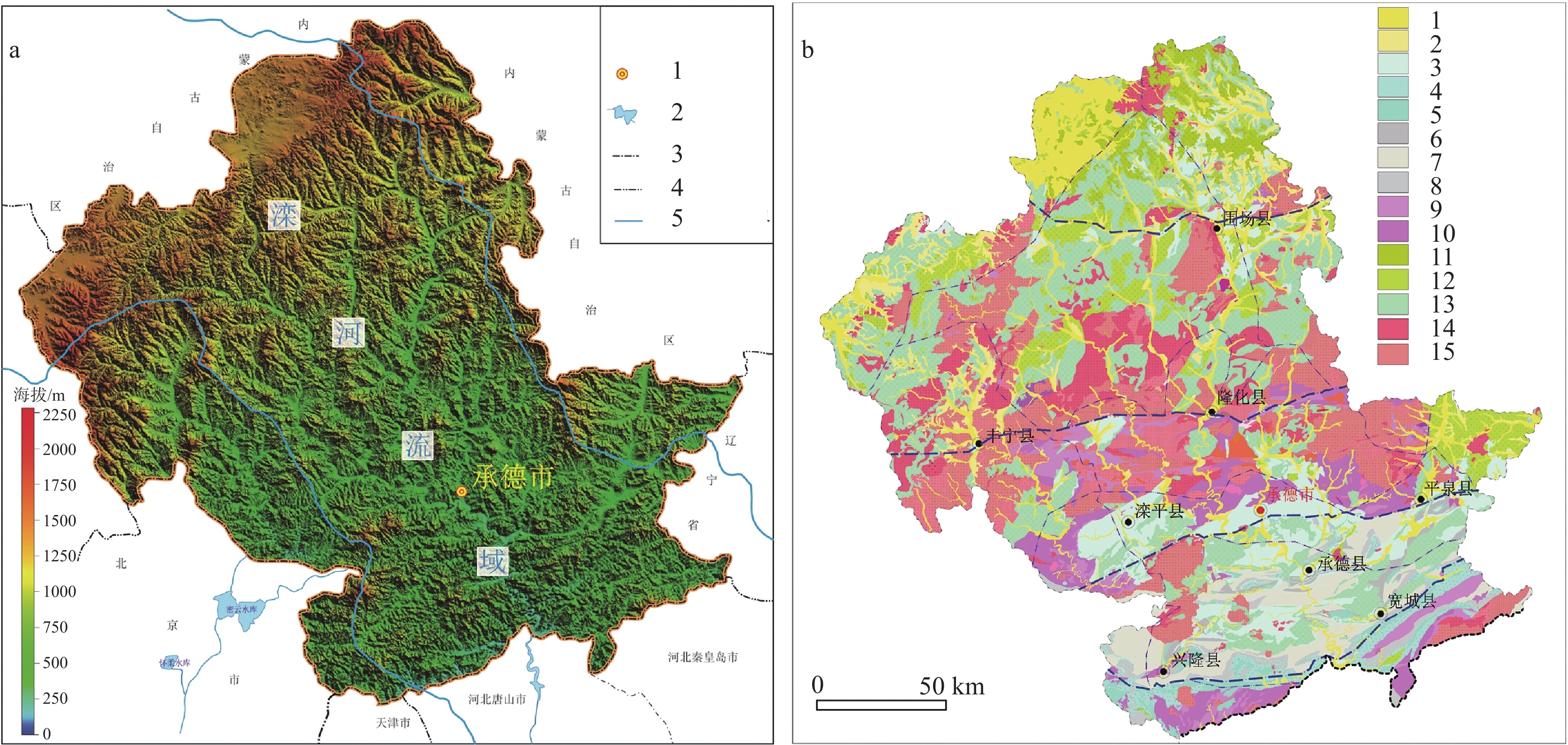
 下载:
下载:
